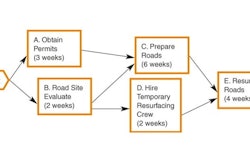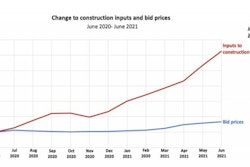
The COVID-19 pandemic has been described as an archetypal “black swan” event, i.e. a major phenomenon that could not have been foreseen and “that took the world by complete surprise,” (Deloitte, COVID-19: Managing cash flow during a period of crisis, 2020). That would be an understatement, such was the disruptive power that the pandemic had on almost every industry. The construction sector was clearly not immune to the surreal ‘new normal’ that arose during 2020 and into 2021.
The disruption caused by COVID-19 to the construction industry was acute, especially for a highly competitive industry, in which margins can often be tight and payments by clients or principal contractors often delayed. The result was an industry that struggled to overcome one of its ever-present challenges: cash flow. For those construction companies that have survived lock-downs and canceled projects, the ability to manage cash flow will be more important than ever in the post-COVID-19 era.
However, maintaining sustainable levels of cash flow for many construction companies is easier said than done. Solving this conundrum is especially important for smaller companies and subcontractors who are often at the mercy of payment schedules and project terms that are beyond their control.
COVID-19 & Its Impact on Construction Cash Flow
The actual impact of COVID-19 on the global construction industry was huge, even devastating. The UK’s independent Office for Budget Responsibility (OBR) calculated that construction probably experienced a reduction in output as high as 70% in Q2 of 2020, which, according to the OBR, would cause “significant cash flow issues for those without significant cash reserves”. Another stunning figure—OBR’s latest data showed that of 325,000 construction companies in the UK, only a mere 250 (or 0,07%) of them are not classified as small and medium-sized businesses (SMBs).
The U.S. had 3,609,869 construction businesses as of mid-2021. The American construction industry grew by 3.3% in 2021 compared to 2020, which is astounding given the impact that COVID-19 no doubt had on the industry. This growth, however, was not replicated in the UK and other Western European countries. Importantly, SMBs comprise a significant proportion of the construction industry in the U.S., as it does in other countries such as Canada and Australia.
The high number of SMBs in the industry is critically important. Many smaller companies in the construction industry struggle to maintain available cash flow on a consistent basis. As such, construction is an industry that is particularly vulnerable to the vagaries of cash flow. This is particularly relevant in the ongoing uncertainty that is the ‘post-pandemic era.
The Essentials of Cash Flow Management
The words "cash flow" sound deceptively simple. They are not. This perception is exacerbated by the fact that construction companies, even the smallest ones, can often have significant amounts of money entering their accounts, thereby giving what is called the “illusion of money”. Cash flow can be likened to a boa constrictor that slowly strangles even the most outwardly successful SMB, and is a leading reason why 66% of businesses fail within 10 years in the U.S., according to the Washington, D.C.-based Small Business Administration.
Simply put, cash flow management stands for the process a business must undertake to ensure the monitoring, analysis, and optimization of the net amount of revenue earned, minus all expenses. A basic understanding of cash flow analysis is essential for any business in its current and future planning. Of critical importance, is determining the break-even point for a given company. That’s the overall or "big picture" approach.
Equally important is cash flow on a project basis. Any business manager knows that some projects carry healthier margins than others and that some projects carry others in terms of the company’s overall profitability. However, every single project should be costed to the minutest detail possible, and with unexpected variables factored in where possible. This will ensure that any such variations, such as unexpected incidental labor, equipment costs, or payment delays, don’t cause massive disruption to cash flow if they occur.
Workforce Management & Shift Organization
An important way to enable and protect better cash flow is to focus on workforce management and shift organization. There is no one-size-fits-all approach that any construction company—big or small—can have regarding how their workers’ time and productivity is planned and managed. A project-driven industry such as construction requires versatility, adaptability, and quick thinking regarding shifts and other time-related schedules for all workers, whether on-site or off-site.
The fundamental focus regarding how workers are managed and their shifts allocated should be three-fold:
- Practicality: Ensure that workers are assigned tasks in a way that is most practical in terms of both their schedules and specific requirements of a given project. For example, shift numbers should correspond precisely with the given phase of a project.
- Efficiency: Streamlined, intelligent usage of labor means that efficiencies can be attained, both logistically and financially. For example, a diverse range of workers within a construction company need their time maximized to ensure corresponding cost efficiencies.
- Cost-effectiveness: Every single aspect of worker and shift management should be planned and implemented through a prism of cost-effectiveness. For example, a mindset that equates labor efficiency with cost savings at all times can be invaluable.
An excellent idea is to rely on workforce management and scheduling software that is fit for your business. Consider it a data goldmine that is readily available at any time, anywhere, and on any device. This type of software can help to:
- Create staff work schedules
- Track employee hours
- Manage shift-swaps
- Improve communication and collaboration between and within teams on a project
- Provide workers with consistency in their schedule
- Help with timesheet reconciliation
- Allow for updated, real-time analysis of labor costs
Intelligent shift and workforce management software can make all the difference for construction companies trying to ensure stable cash flow in the post-COVID "new normal."
Other Solutions to Cash Flow Issues
There are a host of other solutions to cash flow issues (read: inefficiencies) that may arise, even at the best of times. These solutions can be split into two sets of check-lists: basic solutions (i.e. the absolute, obvious fundamentals) and adjunct solutions (i.e. those that are less obvious and may be more complex).
Basic, Immediate Solutions:
➔ Send an invoice out on time, every time. Be consistent.
➔ Follow up constantly and persistently with customers or suppliers regarding past-due-date invoices.
➔ Closeout completed projects. Failing to do so will result in delayed payments.
➔ Have standard protocols for collections in place. For example, a "net 30 days" stipulation for payment, or having a finance charge for outdated invoices, can greatly help the collections process.
➔ Never agree to a customer’s overly delayed payment terms (i.e. 90 days or even 120 days). Negotiate hard and fair from the very beginning for decent payment terms, and make 30 days after invoice a company standard.
➔ Provide incentives for customers to pay on time, such as having a 5% discount for payment before the due date, or enabling online credit card payments.
➔ Communicate your payments policy expressly and openly with all customers and suppliers from the very beginning of any project or collaboration.
Adjunct, Longer-Term Solutions
➔ Avoid using generic or "pro forma" contracts for every single project or supplier. Every contract should be customized where and as needed, particularly in regard to payment-related clauses.
➔ Make good and constant use of cash flow worksheets to project future cash flow credits or deficits. This should include both accounts receivable and accounts payable.
➔ Resolve warranty issues quickly and efficiently. Don’t give a customer a good reason to defer payment on the basis of issues that are often minor or easily resolved.
➔ Strategically manage any retainage terms to which you may have agreed and expressly factor in said terms into your costing for a project or bid.
➔ Work with strong strategic partners whom you trust, and work on a quid pro quo basis whenever possible. Consider them your valued collaborators on projects.
➔ Make every effort to ensure that your entire supply chain is reliable and in good financial standing.
➔ Choose the correct tax structure and strategy for your business. Construction companies in the U.S. have various options regarding how they are taxed. Significant deferrals in taxes owed should always be the aim.
➔ Up-skill your workers in every way possible. A better-trained workforce = A smart and more self-realized workforce = A workforce less likely to make mistakes or suffer from absenteeism or "presenteeism" = A more cost-efficient workforce.
PwC believes companies that will emerge best from the COVOD-19 crisis will be those that have “solid finances, a resilient supply chain, skilled workers and the capacity to gather and analyze the data that decision-makers need.” Those are the companies that PwC contends will be “well-placed to pivot and seize new opportunities.” Be that company.
About the author
Derek spearheads key initiatives at Deputy, a global workforce management platform for employee scheduling, timesheets and communication. With a focus on construction, Derek helps business owners and workforce leaders simplify employment law compliance, keep labor cost in line and build award-winning workplaces. Derek has over 16 years’ experience in delivering data-driven sales and marketing strategies to SaaS companies like MarketSource and Griswold Home Care.


















